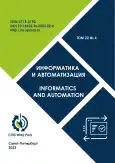Vol 22, No 4 (2023)
Information security
Information-Theoretic Representation of Interception Network Channel Virtualization
Abstract
 721-744
721-744


Optimal Nonlinear Filtering of Information Impact Estimates in a Stochastic Model of Information Warfare
Abstract
 745-776
745-776


Comparative Analysis of Rumour Detection on Social Media Using Different Classifiers
Abstract
As the number of users on social media rise, information creation and circulation increase day after day on a massive basis. People can share their ideas and opinions on these platforms. A social media microblogging site such as Facebook or Twitter is the favoured medium for debating any important event, and information is shared immediately. It causes rumours to spread quickly and circulates inaccurate information, making people uneasy. Thus, it is essential to evaluate and confirm the level of veracity of such information. Because of the complexities of the text, automated detection of rumours in their early phases is challenging. This research employs various NLP techniques to extract information from tweets and then applies various machine learning models to determine whether the information is a rumour. The classification is performed using three classifiers such as SVC (Support Vector Classifier), Gradient Boosting, and Naive Bayes classifiers for five different events from the PHEME dataset. Some drawbacks include limited handling of imbalanced data, difficulty capturing complex linguistic patterns, lack of interpretability, difficulty handling large feature spaces, and insensitivity to word order and context by using the above classifiers. The stacking approach is used to overcome the above drawbacks in which the output of combined classifiers is an ensemble with LSTM. The performance of the models has been analyzed. The experimental findings reveal that the ensemble model obtained efficient outcomes compared to other classifiers, with an accuracy of 93.59%.
 777-794
777-794


AAFNDL - An Accurate Fake Information Recognition Model Using Deep Learning for the Vietnamese Language
Abstract
On the Internet, "fake news" is a common phenomenon that frequently disturbs society because it contains intentionally false information. The issue has been actively researched using supervised learning for automatic fake news detection. Although accuracy is increasing, it is still limited to identifying fake information through channels on social platforms. This study aims to improve the reliability of fake news detection on social networking platforms by examining news from unknown domains. Especially, information on social networks in Vietnam is difficult to detect and prevent because everyone has equal rights to use the Internet for different purposes. These individuals have access to several social media platforms. Any user can post or spread the news through online platforms. These platforms do not attempt to verify users or the content of their locations. As a result, some users try to spread fake news through these platforms to propagate against an individual, a society, an organization, or a political party. In this paper, we proposed analyzing and designing a model for fake news recognition using Deep learning (called AAFNDL). The method to do the work is: 1) First, we analyze the existing techniques such as Bidirectional Encoder Representation from Transformer (BERT); 2) We proceed to build the model for evaluation; and finally, 3) We approach some Modern techniques to apply to the model, such as the Deep Learning technique, classifier technique and so on to classify fake information. Experiments show that our method can improve by up to 8.72% compared to other methods.
 795-825
795-825


Digital information telecommunication technologies
Errors Compensation Caused by Time Delay of Digital Sensors
Abstract
 826-852
826-852


Comparison and Retrieval of Situations in the Case-Based Reasoning System for Smart-Farm
Abstract
 853-879
853-879


Hybrid Optimization Based on Spectrum Aware Opportunistic Routing for Cognitive Radio Ad Hoc Networks
Abstract
Opportunistic routing has increased the efficiency and reliability of Cognitive Radio Ad-Hoc Networks (CRAHN). Many researchers have developed opportunistic routing models, among them the Spectrum Map-empowered Opportunistic Routing (SMOR) model, which is considered a more efficient model in this field. However, there are certain limitations in SMOR, which require attention and resolution. The issue of delay and degradation of packet delivery ratio due to non-consideration of network bandwidth and throughput are addressed in this paper. In order to resolve these issues, a hybrid optimization algorithm comprising firefly optimization and grey wolf optimization algorithms are used in the basic SMOR routing model. Thus, developed Hybrid Firefly and Grey-Wolf Optimization-based SMOR (HFGWOSMOR) routing model improves the performance by high local as well as global search optimization. Initially, the relationship between the delay and throughput is analyzed and then the cooperative multipath communication is established. The proposed routing model also computes the energy values of the received signals within the bandwidth threshold and time; hence, the performance issues found in SMOR are resolved. To evaluate its efficiency, the proposed model is compared with SMOR and other existing opportunistic routing models, which show that the proposed HFGWOSMOR performs better than other models.
 880-905
880-905


Integration of Heterogeneous Information Resources and Earth Remote Sensing Data in Monitoring and Management of Territorial Development
Abstract
 906-940
906-940











